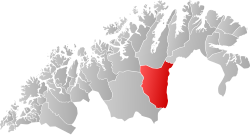Karasjok
![]() Karasjok (info • help) (Northern Sami: Kárášjohka [ˈkʰaːraːʃˌjohka];[3] Kven: Kaarasjoki) is a municipality in Finnmark county, Norway.
Karasjok (info • help) (Northern Sami: Kárášjohka [ˈkʰaːraːʃˌjohka];[3] Kven: Kaarasjoki) is a municipality in Finnmark county, Norway.
|
Kárašjoga gielda Kaarasjoki | |
|---|---|
 | |
 Karasjok within | |
| Coordinates: 69°28′55″N 25°06′18″E / 69.48194°N 25.10500°ECoordinates: 69°28′55″N 25°06′18″E / 69.48194°N 25.10500°E | |
| Country | Norway |
| Established | 1 Jan 1866 |
| Administrative centre | Karasjok |
| Government | |
| • Mayor (2023) | Svein Atle Somby (Ap) |
| Area | |
| • Total | 5,452.95 km2 (2,105.40 sq mi) |
| • Land | 5,209.46 km2 (2,011.38 sq mi) |
| • Water | 243.49 km2 (94.01 sq mi) 4.5% |
| • Rank | 2 in Norway |
| Population (2020) | |
| • Total | 2,628 |
| • Rank | 245 in Norway |
| • Density | 0.5/km2 (1/sq mi) |
| • Change (10 years) | −5.8% |
| Time zone | UTC+01:00 (CET) |
| • Summer (DST) | UTC+02:00 (CEST) |
| ISO 3166 code | NO-5437 |
| Official language form | Bokmål and Northern Sami[2] |
| Website | karasjok |
The municipality (of which the urban area is a part,) has Sami (or Sámi) and Norwegian as official languages.
The municipality is one of two in Norway where the majority of inhabitants speak Sami and have it as their main language.[4]
History
Before the beginning of the 1700s, there might not have been a permanent population there.[5] However the area was used by nomads.[5]
World War II
During World War II a Nazi concentration camp was built in Karasjok: Lager IV Karasjok (German for "Karasjok Camp No.4", Norwegian: [Karasjok fangeleir] Error: {{Lang}}: text has italic markup (help)).[6][7] The camp was run by SS, and it was among[8] the first four Nazi concentration camps in Northern Norway.
In July 1943, 374 political prisoners and POWs prisoners [mostly Yugoslav,] were brought to the concentration camp. They were tasked with widening the road to Karigasniemi, Finland.[9] After four or five months, only 111 of these prisoners were still alive.[9] At the end of the prisoners' stay in Karasjok, before transportation out of Karasjok, 45 prisoners were massacred by the firing of small arms.[9] At least one former prisoner is (as of 2013) still alive.[10]
Later
In 2015 the second edition of Sapmi Pride, the LGBT pride festival, was held in Karasjok.[11] To protest homosexuals attending the Karasjok Church, and to protest that a female priest held the services, Norges Samemisjon cancelled one of their radio broadcasts. [11]
Education
Regarding all the students in elementary schools grades one, two and three: For the last three years (as of 2024), all those students are in classes that have [Northern] Sami as the main language (of those classes).[12]
Main language of students at secondary school
The Sami secondary school, is one of two in Norway (as of 2014);[13] 73% of the schools students say that Sami is their main language; 27% say that Sami is their second language (as of the school year that started in [August] 2009 and ended in [June] 2010);[14] That school is run by the government.
Administration
The municipal council is elected until late 2027.[15]
- 7 council members are from Labour party[16]
- 5 from Karasjoklista
- 2 from Samelista i Karasjok
- 2 from Samefolkets Parti i Karasjok
- 2 from Centre party
- 1 from Conservative party
(The 19 council members were elected during the 2023 Norwegian local elections.)
Related pages
References
- ↑ "Navn på steder og personer: Innbyggjarnamn" (in Norwegian). Språkrådet.
{{cite web}}: CS1 maint: unrecognized language (link) - ↑ "Forskrift om målvedtak i kommunar og fylkeskommunar" (in Norwegian). Lovdata.no.
{{cite web}}: CS1 maint: unrecognized language (link) - ↑ "Stadnamn og rettskriving" (in norsk). Kartverket. Archived from the original on 2018-07-01. Retrieved 2018-07-13.
- ↑ ÁVJOVÁRRI URFOLKSREGION I ET SAMISK PERSPEKTIV[dead link]. page 19
- ↑ 5.0 5.1 Dalfest, Terje; Askheim, Svein (19 January 2019). "Karasjok" – via Store norske leksikon.
- ↑ Sigurd Bakke Styrvold, "Heil og Sæl. Jeg er utdannet morder!" - Den norske SS Vaktbataljon 1942 – 45" (PDF), MA in history - University of Oslo (in Norwegian), p. 14
{{citation}}: CS1 maint: unrecognized language (link) - ↑ Timm C. Richter. Krieg und Verbrechen: Situation und Intention: Fallbeispiele. 2006. p. 114
- ↑ Sigurd Bakke Styrvold, "Heil og Sæl. Jeg er utdannet morder!" - Den norske SS Vaktbataljon 1942 – 45" (PDF), MA in history - University of Oslo (in Norwegian), p. 14,
Det fantes på forskjellige tidspunkter flere serberleire i Norge, men de norske vaktene gjorde bare tjeneste i de fire første; Lager I Beisfjord, Lager II Elsfjord, Lager III Rognan (også kjent som Botn) og Lager IV Karasjok
{{citation}}: CS1 maint: unrecognized language (link) - ↑ 9.0 9.1 9.2 Disse fangene bygget «blodveien» – og så ble de henrettet - De jugoslaviske fangene som var i Karasjok under andre verdenskrig skulle bare bygge veien til Finland, og deretter skulle de ikke eksistere mer. [These prisoners built 'the blood road' - and then they were executed - The Yugoslavian prisoners that were in Karasjok during World War Two, were only to build a road to Finland, and thereafter they were not to exist anymore]
- ↑ Larsen, Dan Robert (24 May 2013). "Følelsesladet møte med Karasjok". NRK.
- ↑ 11.0 11.1 Larsen, Dan Robert (2 June 2016). "Flytter Sápmi Pride til Kautokeino". NRK.
- ↑ https://www.sagat.no/debatt/feil-om-samiskspraklige-i-karasjok-i-ny-rapport/19.42120. Sagat.no. Retrieved 2024-01-04
- ↑ Fornyings-, administrasjons-og kirkedepartementet (20 August 2018). "Fakta om samiske språk". Regjeringen.no.
- ↑ "Urbefolkningen i tall - samisk statistikk". ssb.no.
- ↑ https://www.sagat.no/nyheter/her-er-karasjoks-kommunestyre/19.40969. Retrieved 2023-10-23
- ↑ https://www.nrk.no/valg/2023/resultat/fylke/56/5610. NRK.no. Retrieved 2023-09-26

